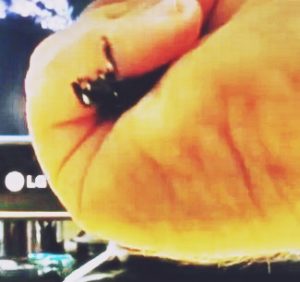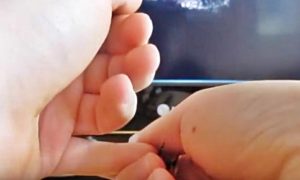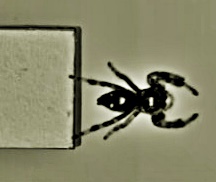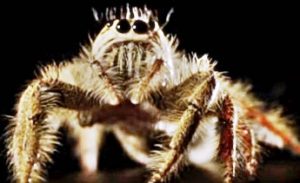
Jumping spiders are a species of spiders which are a part of the Salticidae family. They get their common name from its ability to jump, often for the purpose of catching its prey. There are over 3999 types of jumping spiders on the planet with the US and Canada accounting for over 290 species, which includes the famous zebra spider.

Physical Characteristics of Jumping Spiders
Jumping spiders have black compact bodies and comparatively short legs. Hence, they are often mistaken to be black widow spiders. It may however be noted that jumping spiders can also be gray, tan, or brown in color with yellow, pale white, blue, gray, green, or red markings. Some males may have glistening bodies. Jumping spiders are famous for their leaping capacities and quick reflexes. They can jump as high as nearly 25 times their size and are very good predators.
Adults can grow anywhere between 1/8th and 3/4th of an inch in size. Their bodies are covered in thick hair or iridescent or vibrantly colored scales. As compared to the hind legs, the front ones are slightly longer and thicker. The size of male zebra spiders ranges from 1/8th to 1/4th of an inch, while females are 3/16th to 1/4th of an inch. Adult zebra jumping spiders feature gray bodies with white marks on the abdomen and front. The legs are brown or white with gray striped rings, just like a zebra.
Jumping spiders are considered to have the best sight as compared to other spider spiders. It can detect and respond to motion nearly 45 centimeters away. Their night vision is however really poor. It has 8 eyes located in 3 rows. Four eyes are present at the highest place on the carapace, while four are located on the face. The middle pair of eyes on the face is really big, tube-like and long. They have high resolution but restricted perspective. As opposed to this, the other eyes have a larger field of view and low acuity.

Jumping Spider Bite – Is it poisonous?
Jumping spiders are not considered to be harmful to humans, particularly due to the fact that they generally tend to scurry away instead of attacking people. They may however attack and bite when they feel threatened. It is therefore advisable to use gloves when gardening. These spiders have fangs that secrete venom, but their poison is not considered to be a medical emergency unless if a victim is allergic to the venom.
Mild symptoms of jumping spider bite include sharp pain, which may not cause much bother and some irritation and redness that ease in 1 to 2 days.
Serious symptoms include swelling, headaches, nausea, cramping, pain, itchiness, and fever. It is important to consult a doctor in case you experience these symptoms.

Jumping spider bite – treatment
Home remedies for mild symptoms include:
- Application of an ice pack at the bite site for 10 minutes per session
- Antihistamines for alleviation of itching
- Reduction of swelling by keeping the bite area elevated
- Preventing possible infections by cleaning the site
- Application of a topical antibiotic in case of blister formation
Other characteristics of Jumping Spiders
Home: Jumping spiders do not build webs to snare prey. Instead it constructs saclike, loosely-woven web retreats that are made up of many envelopes. These retreats are usually shaped like a lens and suspended from a wall like a hammock. They are used for hibernation, molting, laying eggs, and nighttime isolation. The spiders will often construct a new web-home for each new activity.
Indoors, jumping spiders and their hammock-sacs may be found on walls, under furniture, ceiling, between books, window moldings and sills, in drapery folds, around door moldings, in cracks and gaps on wooden floors, and other areas where there is better sunlight for better vision and where there are more insects.
Outdoors, jumping spiders may be found in sunlight places like under stones, logs, leaves, or loose bark; along decks and fences, and on bushes, etc. They are unlikely to invade and infest a house as they like the outdoors with lots of sunlight and vegetation, especially environments like prairies and grasslands. They may be accidently carried indoors by humans via clothes or plants.

Zebra jumping spiders mate during the month of May. The eggs get laid in June and/or July. Each egg sac of jumping spiders may have 14 to 24 while colored eggs. The hatchlings spend the winter in the sacs and turn into adults in spring, and are often observed from April to July. Adult females are seen from mid May to late Oct, feeding on insects near doors and windows.
Diet: Jumping spiders like sunshine and often hunt during the day. They can quickly move backwards and sideways over short distances and then jump and pounce on their prey. The spiders use silk to make a dragline when jumping; the dragline prevents them from falling and operates as an anchor and a safety line. Thus, when it jumps on a prey and if the prey manages to shake it off, the dragline allows them to tether back. The circulatory system plays a big role in the rapid mobility of jumping spiders. Rise in the blood pressure in their legs causes the body to move via manner of released pressure. After latching onto a prey, the spider bites and injects its venom into it, thereby paralyzing it and permitting the spider to ingest the prey.
Jumping spiders eat different types of small insects, including cotton leaf worms, bollworms, webworms, stinkbugs, cotton flea hoppers, mosquitoes, and leafhoppers.
Jumping spiders escape from predators in varied ways. Some may use camouflage and merge and blend with the surroundings, while other species may stay watchful and alert for prey as well as predators. If they feel danger, then they tend to hide or flee.

Getting rid of jumping spiders from home
- You can vacuum the house and eliminate jumping spiders from your home. Call an exterminator in case there is an infestation.
- You can prevent jumping spiders from entering the house by sealing all cracks and gaps in walls, floors, window and door moldings, etc.

Leave a Reply